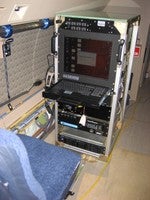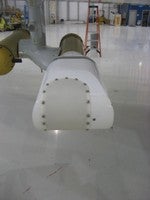 This list describes many of the basic measurements made on the NSF/NCAR GV aircraft, also know as State Parameters. State Parameters give the scientist a measurement of the current state of a particular parameter.
This list describes many of the basic measurements made on the NSF/NCAR GV aircraft, also know as State Parameters. State Parameters give the scientist a measurement of the current state of a particular parameter.
These measurements are used by the scientists to have a better understanding of the physical measurements that their instruments are collecting. The State Parameters are used in conjunction with the data collected by the researchers to provide the most accurate data set possible. Measurements of altitude, latitude, longitude for example, give an exact location in space (and time) of the specific measure of a trace gas. The scientists can then imply on the physical, chemical and spatial characteristics of the measurement. The rest of the variables are used also by the scientists to make corrections or adjust their data set depending on the conditions that the airplane experienced.
Microwave Temperature Profiler | MTP
 The Microwave Temperature Profiler (MTP) is a passive remote sensing system that provides researchers with atmospheric temperature structure above and below the aircraft. Basic components of the MTP are a receiver which measures emission by oxygen molecules at three microwave frequencies and a scanning mirror which views the emission at 10 elevation angles. The three microwave frequencies have different penetration depths so the sensor is able to See to different distances from the aircraft with each channel (the plastic window covering the sensor showed in the attached photo is transparent at microwave frequencies). Different effective viewing distances are also achieved by scanning in elevation. With three frequencies and 10 elevations angles, 30 separate measurements of brightness temperature are acquired with each 18 second scan. Calibration is performed as the scanning mirror views an internal target during each scan. A statistical retrieval algorithm is applied to convert the brightness temperature observables into temperature as a function of altitude.
The Microwave Temperature Profiler (MTP) is a passive remote sensing system that provides researchers with atmospheric temperature structure above and below the aircraft. Basic components of the MTP are a receiver which measures emission by oxygen molecules at three microwave frequencies and a scanning mirror which views the emission at 10 elevation angles. The three microwave frequencies have different penetration depths so the sensor is able to See to different distances from the aircraft with each channel (the plastic window covering the sensor showed in the attached photo is transparent at microwave frequencies). Different effective viewing distances are also achieved by scanning in elevation. With three frequencies and 10 elevations angles, 30 separate measurements of brightness temperature are acquired with each 18 second scan. Calibration is performed as the scanning mirror views an internal target during each scan. A statistical retrieval algorithm is applied to convert the brightness temperature observables into temperature as a function of altitude.
The MTP is fixed to the under-side of the right wing of the aircraft, next to the Forward Looking Camera and the Ultra-High Sensitivity Aerosol Spectrometer (UHSAS).
Inertial Reference System (IRS) Variables
Honeywell HG2001GD Laseref SM Inertial Reference System (IRS) is used to obtain aircraft position, velocity, acceleration and attitude information.
- Latitude (deg)
- Longitude (deg)
- Aircraft True Heading (deg)
- Aircraft Pitch Attitude Angle (deg)
- Aircraft Roll Attitude Angle (deg)
- Aircraft Vertical Acceleration (M/s2)
- Inertial Altitude (M)
- Aircraft Ground Speed (M/s)
- Aircraft Ground Speed East Component (M/s)
Global Positioning System Variables
GPS variables aboard RAF aircraft are gathered by a Trimble TANS-III GPS receiver. It has the ability to track up to 6 satellites at a time but needs only 4 to provide 3-dimensional position and velocity data (3 satellites for 2-dimensions). The accuracy of the position measurement is stated to be 25 meters (horizontal) and 35 meters (vertical) under "steady-state conditions." Likewise, velocity measurements are within 0.2 M/s for all axes.
- GPS Latitude (deg)
- GPS Longitude (deg)
- GPS Ground Speed (M/s)
- GPS-Computed Aircraft Vertical Velocity (M/s)
- GPS Altitude (M)
Aircraft & Meteorological State Variables
Meteorological and aircraft state measurements are made at various locations on an aircraft. The present radome measurements all have pressure sensors located in the nose area of the aircraft connected to the radome by semi-rigid tubing.
- Attack Differential Pressure (mbar)
- Sideslip Differential Pressure (mbar)
- Reference Attack Angle (deg)
- Static Pressure (mbar): ¨This is the output from a calibrated absolute (barometric) transducer. The value is a static pressure corrected for local flow-field distortion.
- Dynamic Pressure (mbar): This is the output from a calibrated differential pressure transducer. The measurement is the difference between a pitot (total) pressure at location x and a static pressure.
- Total Temperature (C): This is the output of the recovery temperature from a calibrated temperature sensor at location x.
Thermodynamic Variables
- Ambient Temperature (C): The ambient temperature (also known as the static air temperature) is calculated from the measured recovery temperature, which includes dynamic heating effects, using conservation of energy for a perfect gas undergoing an adiabatic (in this case, deceleration) process.
- Aircraft True Airspeed (M/s): This is a derived variable based upon a Mach number calculated from both the dynamic pressure at location x and static pressure.
- Water Vapor Pressure (mbar): This is a derived intermediate variable used in the calculation of several derived thermodynamic variables. The vapor pressure is obtained from the Goff-Gratch Formulation (1946).
- Potential Temperature (K): This is a derived variable from the definition of potential temperature
- Virtual Temperature (C): The virtual temperature is the temperature of dry air having the same pressure and density as the air being sampled. It is a measure of the effect of water vapor on air density.
- Relative Humidity (per cent): Derived output of relative humidity from definition
- Mixing Ratio (g/kg): A derived variable that is expressed in terms of grams of water vapor per kilogram of dry air.